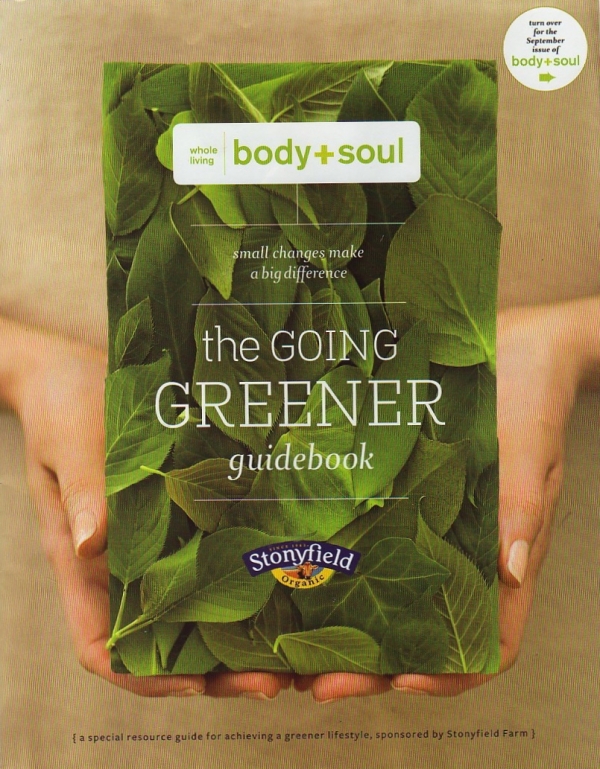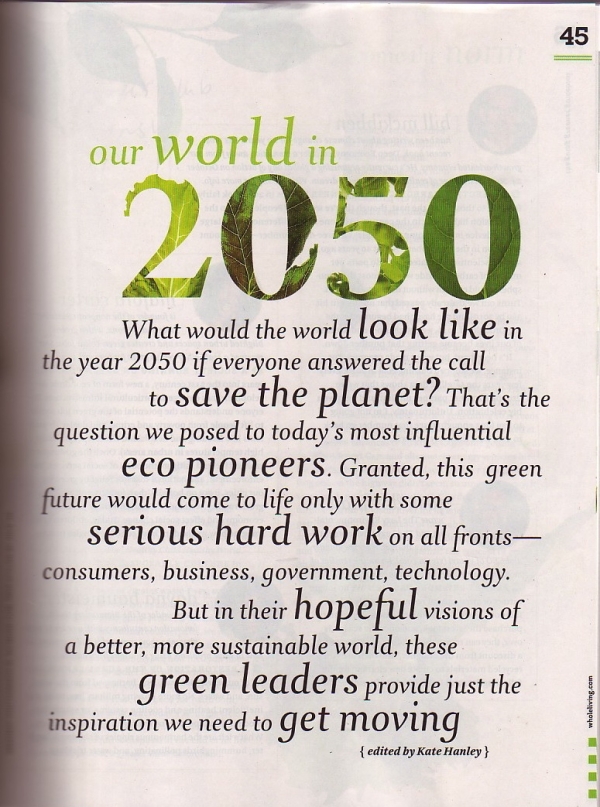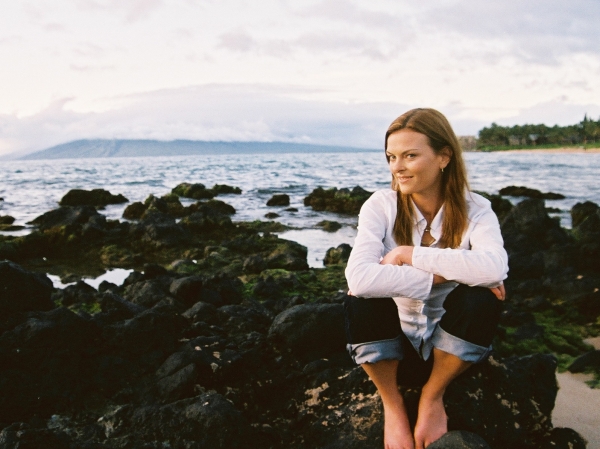Body + Soul Magazine Our World in 2050
What would the world look like in 2050 if everyone answered the call to save the planet? That's the question we posed to today's most influential eco-pioneers. Granted, this green future would come to life only with some serious hard work on all fronts - consumers, business, government, technology. But in their hopeful visions of a better, more sustainable world, these green leaders provide just the inspiration we need to get moving.
Edited by Kate Hanley
{ bill mckibben }
has been writing about climate change for 20 years. His most recent book, Deep Economy, calls for a transition away from our growth-oriented economy. He's currently organizing a global day of action on October 24, 2009, in the hope of realizing the following dream. Visit 350.org for more info.
COLLECTIVE CARBON CONSCIOUSNESS • Houses in 2050 look fairly familiar to those from the past, though they're smaller. (People gave up the McMansion habit in the early century). The one main difference is the large digital device in every home that displays a three-digit number - the amount of carbon in the atmosphere. About 40 years ago, a NASA scientist calculated that 350 parts per million of carbon dioxide was the most the atmosphere could contain without dire consequences. Turns out we'd already passed that number (it hit 390 by 2010) and the havoc had begun. After the Big Drought of 2012, we caught on - and the task of our lives became getting the number down. It's been hard, but we've made progress. For instance, we stopped burning coal in 2030. Every few years the satellite data shows that we've dropped another part per million, and we have a big celebration. Unfortunately, I'm not going to live long enough to see that number go back to 350, but I think my kids will.
{ majora carter }
is the founder of the nonprofit Sustainable South Bronx, which green blighted urban spaces and creates green-collar jobs. She received a MacArthur genius grant for her work in 2006.
A SOCIETY RUNNING ON GREEN JOBS • Fifty years into the 21st century, a new form of economic development has emerged: horticultural infrastructure. Everyone understands the potential of the green job sector to lift people from poverty and crime, and deal with problems like flooding and heat island effect (exceptionally high temperatures in urban areas). Once the government realized it could mitigate the costs of social services, law enforcement, and national disaster relief by greening our cities, it got on board. Urban forestry and agriculture, green roofing, wetland restoration - these jobs fuel the economy and effect social change. Today, children can't imagine how we lived in those concrete jungles in 2009.
{ joel salatin }
is a proprietor of Polyface Farms in Swoope, Virginia, a self-described "lunatic farmer", and author of several books on environmentally friendly farming, including Salad Bar Beef and You Can Farm.
A HEALING ETHIC PREVAILS • In the world according to me, healing - not money - serves as the primary success yardstick. Farms in 2050 enjoy a newly energized and vibrant soil community that has reinvigorated our plants to preindustrial-era nutiritonal levels. These nutrients satisfy our bodies so we no longer crave Twinkies and Dunkin' Donuts. Pasture-based meat, poultry, dairy, and eggs rich in carotenes and omega-3s stimulate our brains to reach their full genetic potential. This has induced creativity, learning, and emotional balance and has emptied out hospitals and pharmaceutical treasuries. With a healing ethic dominating the food system, the sacred farm-to-fork relationship has fostered a culture that respects and honors animal's natural behaviors, the land, and the people who depend on it. Transparency - the inherent integrity created when neighbors can see what goes in the front door of a farm and what comes out the back - has fundamentally transformed our food system.
{ renée loux }
is an author of 4 books, including Easy Green Living, an organic and sustainable food chef and restaurateur, green consultant, and product developer. She also hosted the show It's Easy Being Green on the Fine Living network.
THE NEW GREEN NORM • About 45 years ago, a fairly large wid project was erected in West Maui, Hawaii, near my home. At first, these 20 giant windmills seemed like eyesores, but when they started generating 10 percent of the island's energy, I felt grateful every time I looked at them. Green advances of all kinds took some getting used to. When Smart Cars and alternative energy vehicles hit the roads, they looked out of place, but over time, spotting one on the highway didn't seems so unusual. Today it only seems natural that New York City depends on water turbines in the Hudson River for its energy rather than on petroleum and coal. Instead of heat-absorbing tar roofs atop every building, we now see gardens, solar panels, and waste-filtration systems. The concept of green hit the mainstream a long time ago, and we've come to expect it in everything we do.
{ josh dorfman }
wrote the Lazy Environmentalist and The Lazy Environmentalist on a Budget. He is the founder and CEO of Vivavi (vivavi.com), an online retailer of modern, ecofrindly home furnishings.
PLANET-FRIENDLY FASHION • We no longer extract or grow natural resources simply to look fabulous. Every new fashion season, consumers purchase the latest look, and once the season is over, they can return their clothes in exchange for a discount from the designer, who uses these recycled materials to create new clothing for the following season's fresh - and eco-friendly - line.
{ dayna baumeister }
is cofounder of the Biomimicry Guild, and innovation consultancy with a cadre of biologists who show companies and communities how to solve problems using solutions from nature.
A RESTORATION OF AURAL LANDSCAPE • All of our energy is now silent, harnessed from the wind, sun, and waves. No more buzzing military jets, noisy and inefficient heating and cooling systems, or sputtering modes of transportation running on gasoline. What's left are the harmonious ripples of children's laughter, hummingbirds pollinating, and water trickling.
{ jeffrey hollender }
is cofounder and "chief inspired protagonist" of Seventh Generation, a brand of natural cleaners and recycled paper products. He serves on the board of Greenpeace USA and is on the advisory board of Healthy Child Healthy World.
A SHIFT FROM DISPOSABLE CULTURE • In 2009, we came to understand that any product that consumes resources and creates waste - yes, even recycled paper towels - isn't sustainable. Although we're proud that our original products did less damage than the conventional counterparts, we worked to change the portfolio of what we sold. For instance, when we think about laundry, we now focus on fibers that are less likely to get dirty rather than how to constantly clean them. We've envisioned a diaper than consumes a tenth of the resources. Our need for bathroom tissue hasn't gone away, but today's TP helps clean and purify water when you flush it. Bottom line: Anything that requires disposal at the end of its life span has to provide a greater value beforehand.
{ brent blackwelder }
is president of Friends of the Earth and has been an environmental crusader for more than 40 years. As the most senior environmental advocate in Washington, he has testified more than 100 times before Congress on pressing environmental issues.
AN EARTH-FRIENDLY BUSINESS PARADIGM • Before we reformed our economy, we destroyed species we didn't even know existed, degraded the oceans, and deforested the earth. We worshipped industry, condoned companies that polluted, and never even considered that what we created might harm us in the long-run (think: asbestos). If something broke, it was cheaper to buy a new one than get the old one repaired. Why? Our tax code rewarded the use of raw resources and punished reuse. Half the states even exempted pesticides from sales tax. Today, we've ditched frontier economics, the idea that the world has infinite resources. We no longer look at quarterly returns; industry instead looks at the long-term benefits and potential harms of the products it creates. As simple as this sounds, we've come to realize that we live on this planet, and we should be a part of it.
{ gloria flora }
has worked as a steward of public lands for the Forest Service for 22 years. She's now director of the nonprofit Sustainable Obtainable Solutions (s-o-solutions.org), which works to preserve the health of public lands and the plants, animals, and communities that rely on them.
NATURE AS OUR ULTIMATE MODEL • Biomimicry - applying nature's best systems and designs to the human world - plays a huge role in how we solve problems. For instance, coral removes calcium and carbon from seawater and uses them as building blocks. Following that lead, we now extract carbon dioxide from the atmosphere and convert it into our own building materials. Meanwhile, plumbing pipes come lines with the same material found in an abalone shell. It's tougher than ceramics, and nothing sticks to it, eliminating the need for toxic drain cleaners to remove clogs. Nature inspires the daily needs of our civilization. After all, what helps nature also helps us.
{ richard heinberg }
is senior fellow of the Post Carbon Institute and the award-winning author of nine books, including The Party's Over and Peak Everything. He has appeared in numerous documentaries, including Leonardo DiCaprio's The 11th Hour, and received the M. King Hubbert Award for Excellence in Energy Education.
LIVES CENTERED ON COMMUNITY, NOT FOSSIL FUELS • Through a combination of global agreements and individual initiative, we finally managed to reenvision a human society -food systems, transportation, health, education, and so on- that operates without fossil fuels. Today, people spend much more of their time growing their own food. Towns and cities contain smaller, self-sustaining neighborhoods, and most travel occurs by foot or bicycle. People live in older buildings retrofitted for optimum energy efficiency or in new houses made of local, natural materials such as earth, straw, stone or wood. Extended families live and work together. Frequent community festivals feature local live music, lectures, political discussions, and games, and people enjoy more free time and time outdoors. The resurgence of songbird populations indicates that we're on the right track.
{ taylor francis }
started giving climate change presentations when he was just 14, with Al Gore as his mentor. Since then, the 17-year-old has presented more than 50 talks, reaching 20,000 people.
A GREEN LEGACY FOR FUTURE GENERATIONS • Young people recognized 40 years ago that being an environmentalist entailed more than just saving trees and owls; it was about saving ourselves and our future. We claimed our power as agents of change and took action on a local level by greening our schools and homes, and on a national level by voting for candidates who understood the crises we faced and who took action in Congress. As we got older, we passed on these morals to our children and grandchildren. All citizens consider making choices that protect the environment an integral part of their civic duty.
{ andrew winstin }
advises some of the world's leading companies on ways to profit from environmental thinking. He is the coauthor of the best-seller Green to Gold, and author of Green Recovery.
COMPANIES COMPETING TO OFFER THE GREENEST PRODUCTS AND SERVICES After decades of pressure on businesses-from natural resource constrains to new demands from key "stakeholders" such as customers, employees, and governments-green business has become the norm, not the exception. A generational change has transformed the way we conduct business. Today, employees and executives see no trade-off between profit and sustainability. In fact, they know that the two are entirely interdependent. The members of the generation that comfortably shared lots of information on Facebook and MySpace now expect more openness from the companies they buy from and work for. With new technologies and the power of the Internet, consumers now have the ability to easily find out how much energy and water went into making a product, who made it and where, and whether the workers received a fair, living wage from their employers. Companies no longer fight efforts to improve the environment; they compete to offer it.
{ heidi cullen }
is a climatologist and a senior research scientist for Climate Central, a nonprofit that analyzes, synthesizes, and communicates the latest findings about climate change. She won the National Wildlife Conservationist Award for Science in 2008.
WEATHER AS A FRIEND, NOT A FOE • We now view weather as more of a source for clean, home-grown energy than a destructive force to battle every day. We're a country rich in natural energy resources, thanks to the wind belt that extends from Texas to North Dakota and the solar belt in the Southwest. We still use some fossil fuel-based power because the sun doesn't always shine and the wind doesn't always blow. But the coal companies now rely on technology that captures CO2 emission. We've protected many important aspects of the climate system, including polar ice sheets. We've even prevented water shortages. Today, people enjoy climate-friendly technology and weather-resilient cities.
{ hunter lovins }
is founder and president of Natural Capitalism Solutions, which advises countries, communities, and companies on incorporating sustainable practices. She's also a founding professor of Sustainable Management at the Presidios School of Management.
MORE GLOBAL AID • Thanks to improvements in the way we travel-ships use sky sails to harness the wind and airplanes fly on carbon-neutral jet fuel-we now visit countries around the world without contributing to climate change to get there. As a result, a wider array of aid groups have cropped up, offing global the chance to remediate previously inflicted environmental damage. Young people, entrepreneurs, and retirees alike promote the health of the planet and its residents with "volun-tourism", enjoying the travel experience through outfits like Engineers Without Borders and Oxfam. Teaching sustainable agriculture, providing water and renewable energy, constructing net-zero housing, and training budding entrepreneurs to adopt green practices, these tourists have transformed international development.
{ mark bittman }
writes "The Minimalist" cooking column for the New York Times. His most recent book, Food Matters: A Guide to Conscious Eating, explores how a simple shift in diet can greatly promote individual and environmental health.
A HEALTHIER DIET • People eat 90 percent less food from the animal kingdom than they did 40 years ago. No, we're not all vegans now; we've simply reversed the animal-to-plant ratio on our plates. We also consume more whole ingredients over highly processed, energy-intensive foods. North America is divided into several regions, each one largely responsible for growing its own food, minimizing the cost and ecological impact of transporting food across the country. We grow crops conscientiously and treat the animals we raise for food humanely. People cook more often and create simple, flavorful dishes like oatmeal for breakfast; raw fruit and vegetables for lunch; beans, grains, vegetables and sometimes meat or fish for dinner-and that generates more appreciation for the ingredients we eat and where they come from.
{ annie leonard }
has spent 20 years studying the environmental impact of consumerism and materialism. Her 20-minute documentary and upcoming book, The Story of Stuff, uncovers the hidden cost of our addiction to consumer goods.
LESS STUFF • A number of factors lead to the explosion of personal consumption we witnessed in 2010. Economic policies favored new, rather than recycled, materials. Product designers constantly changed the designs of their products to embarrass consumers who retained out-of-date items. Advertising invaded our entertainment, news, clothing, and even our schools with incessant messages that linked our self worth with the acquisition of new stuff. Massive overconsumption led to three things. First, we trashed the planet. All that increased consumption required increased mining, cutting, drilling, hauling, synthesizing, processing, and packaging. And that, of course, created more pollution, decimated forests, contaminated water, and drastically changed our climate. Second, we trashed ourselves. These products and their manufacture used toxic chemicals that eventually seeped into our homes, our workplaces, our food, and our bodies. The kicker? We weren't even having fun with all of our stuff. We worked longer hours, with less leisure time than our parents and grandparents. Our personal consumer debts-and the clutter in our homes-weighed us down. Our communities eroded. We didn't know our neighbors. We had more TVs but fewer friends. We soon realized that our excessive shopping diminished, rather than added to, our quality of life. By buying less and sharing more, we could prevent pollution, conserve resources, and build community. By 2050, we finally replaced the ever-powerful drive for "beter, bigger, more" with the deliciously liberating and satisfying concept of "enough," and that's when we really started having fun.
{ robin chase }
cofounded and served as the CEO of Zipcar, a car-sharing company that has reduced the number of personally owned vehicles on the road. She recently founded GoLoco.org, a social networking site that connects users for ride sharing, making friends, and saving travel money.
NO ONE OWNS A CAR • Long gone are the days in which everyone mostly travels by car. Instead, we rely on a wide range of transportation alternatives: foot, bike, electric scooters, subways, trolleys, and buses. Interchanging among these modes of travel throughout urban areas is a snap, thanks to dependable schedules, finely tuned road maps, and a simple payment system that allows you to transfer seamlessly from one travel method to the next. Just swipe you card and go! We can access the best beaches, lakes, mountains, oceans, and meadows by train and public transit. Shared cars-yes, just use your travel card-carry us those last miles and to the most remote locations. (Tell anyone in the year 2050 about how you used to own a car, and they'll balk the idea that you spent a fifth of your income toward it.) Getting out of town is easier, cheaper, and more convenient. And congestion andtraffic jams? They haven't made news in years.
{ nina simons }
is the president and cofounder of Bioneers, a nonprofit organization that hosts an annual environmental conference for environmental leaders from all disciplines in the name of fostering community, connection, and information sharing.
LAWS SUPPORT OUR HEALTH AND THE EARTH • The constitution now protects nature from assault, and corporations no longer have the rights of personhood. We've wrested the airwaves, waterways, food system, and intellectual commons from corporate control and returned them to the service of the common good. People participate in democracy, letting their legislators know often and loudly where they stand on issues of the day. Each of us acts as guardians of natural areas, species, and waterways, speaking on their behalf in community deliberations.
{ ian kim }
advocates for legislation that create quality, career-track jobs in environmental industries as the director of the Green-Collar Jobs Campaign at the Ella Baker Center for Human Rights in Oakland, California.
THRIVING CITIES AND A LOWER CLASS LIFTED OUT OF POVERTY • By ripping highways and putting in mass-transit systems, installing and maintaining millions of solar panels and thousands of wind turbines, retrofitting old buildings, and moving people closer to where they work and play, we've put money back into our communities. We've taken charge of our own destinies, revitalizing inner-city schools, reducing the number of incarcerates young adults, and creating local, vibrant, and resilient economies where people of all classes have work to do.




